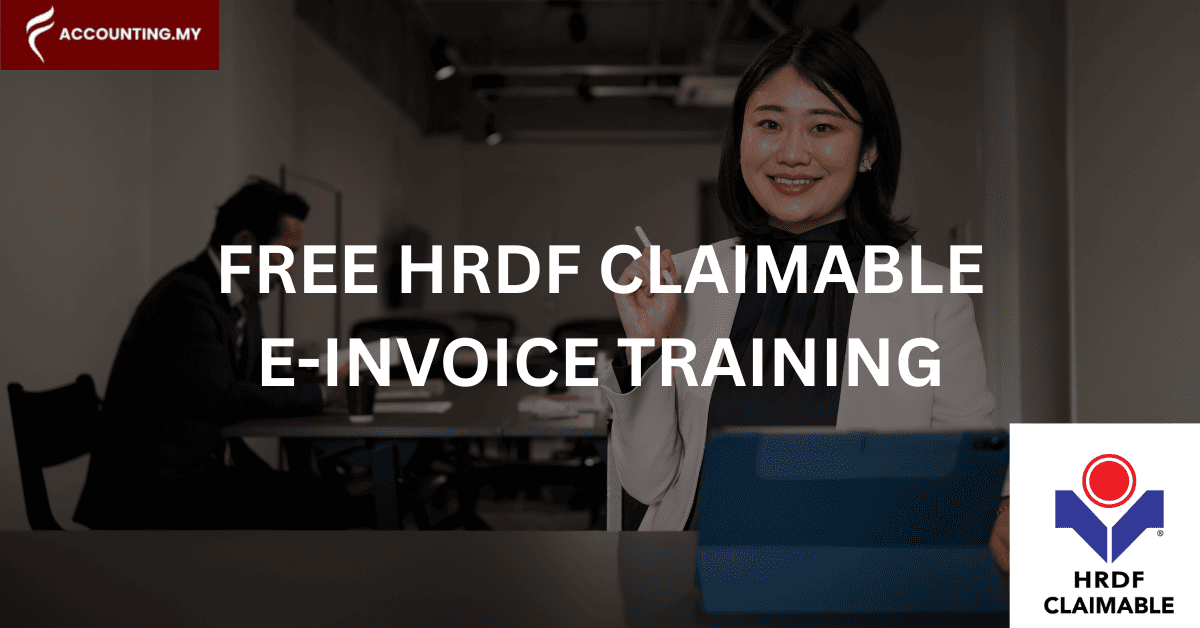Key Takeaways
- In-person hands-on e-invoice training built for Malaysian businesses
- 100% FREE if your company contributes to HRD Corp (SBL-Khas approved)
- Includes live MyInvois demo, invoice creation, Peppol flows, and rejection handling
- Certificate, post-course checklist, and templates provided
- Built by actual accountants, not corporate theorists
- Perfect for SMEs, accountants, finance staff, and ERP implementers
Look, we could give you a long-winded lecture about “digital transformation” and “the importance of compliance readiness,” but let’s cut to the chase.
E-invoicing is mandatory in Malaysia.
It’s rolling out between 2024 and 2026, and your business, big or small will be affected. If you don’t start issuing e-invoices through MyInvois (LHDN’s system), you risk:
- Penalties under Section 120(1)(d)
- Rejected SST claims
- Rejected payments from clients
- Audit trail nightmares
That’s why we created a HRDF claimable e-invoice training course, and it’s 100% free, so long as your company contributes to HRD Corp.
Who This Is For
Most businesses aren’t ignoring the mandate, they just don’t know where to start. Between the acronyms (IRBM, Peppol, API) and scattered PDFs, it’s easy to feel overwhelmed.
But this course isn’t just for “accountants”, If your team:
- Sends invoices
- Handles billing or credit notes
- Sets up finance software
- Deals with tax submissions
Then this is for you. It’s specifically built for:
- SME owners & directors
- Finance executives
- Tax agents & SST consultants
- Admin staff handling invoicing
- ERP/software integrators
- Shared service finance teams
Basically, if you generate any invoices in Malaysia, LHDN expects you to get this right.
What You’ll Learn in this E-invoice Training Course
Forget long lectures and 100-slide presentations.
This training is built around real-world application, not just textbook definitions. By the end of the session, your team won’t just know the theory, they’ll actually be able to issue, validate, and troubleshoot e-invoices confidently.
Here’s what we covered:
Module | Overview |
Foundations of E-Invoice | Understand IRBM rules, MyInvois basics, and core terms |
Usable Scenarios | Learn how e-invoicing applies across business types |
Early Planning Strategy | Build internal readiness with the right processes |
Supplier/Buyer Coordination | Coordinate validation flows across trading partners |
Live Demo + Self Creation | Generate and validate sample invoices in real-time |
1. Foundations of E-Invoice
We begin by breaking down Malaysia’s e-invoicing model, what IRBM expects, how the MyInvois platform works, and where Peppol fits in. You’ll also learn about required invoice fields and validation steps.
2. Usable Scenarios
See how e-invoicing applies to real-life situations: B2C retail, B2B sales, disbursements, exports, and credit/debit notes. We walk through each scenario so you understand which rules apply, and when.
3. Early Planning Strategy
Before e-invoicing becomes mandatory for your company, there’s planning to do. We cover what to prepare in advance, from SOP setup, staff roles, to identifying gaps in your current invoicing process.
4. Supplier/Buyer Coordination
E-invoicing isn’t one-sided. Learn how to work with suppliers and customers in request-response flows, avoid common rejection errors, and ensure both sides stay aligned with MyInvois requirements.
5. Live Demo + Self Creation
No better way to learn than by doing. You’ll create a sample e-invoice, submit it via a MyInvois simulation, and learn to read system response codes, including what to do if something goes wrong.
Very simple, straightforward and easy.
Is This Training Really FREE?
It is! If your company contributes to HRD Corp, this e-invoice training is 100% claimable under the SBL-Khas scheme.
That means:
- No out-of-pocket cost for you or your team
- Claim process handled by us, you just register and show up
- Full training, materials, and certification included
It’s the same training we offer to paying clients, just subsidised by the government for companies like yours. If you’re unsure whether your company is HRD Corp-registered, ask your HR or contact us! We can help you check!
Common Mistakes Companies Make Before E-Invoicing Goes Live
Even with good intentions, many businesses fall into the same traps when preparing for LHDN’s e-invoicing rollout. Here’s what we see most often, and what you’ll learn to avoid in our training:
Mistake #1: Assuming Your Existing Software Is Compliant
Not all accounting software integrates with MyInvois or Peppol out of the box. You’ll need to check compatibility, API availability, or whether manual upload is required.
Mistake #2: Waiting for the Deadline to Get Started
The system isn’t as “plug and play” as people expect. There’s validation, format testing, internal SOP alignment, and even customer/vendor communication required.
Mistake #3: Not Involving the Right People
Sometimes it’s just the accountant attending training, but e-invoicing impacts sales, admin, finance, and even IT. We recommend sending at least 2–3 key team members to ensure smooth implementation.
Mistake #4: Confusing “Invoice” With “E-Invoice”
An invoice PDF or Excel isn’t an e-invoice. If it’s not validated through MyInvois or an approved Access Point, it doesn’t count, and may be rejected during audits or SST filings.
We cover all these points in training so your team can avoid costly last-minute surprises.
How to Claim HRDF for E-Invoice Training (Step-by-Step)
You might be wondering how the usual HRD Corp claim actually works. Don’t worry, we’ve got it down to a science.
1. Get a Quotation
A formal training quotation will be provided by the HRD Corp Registered Training Provider.The company must be an active HRD Corp contributor.
2. Register on ETRiS
The company’s HR or training coordinator registers the course and daily allowance on the Employer ETRiS system.
Note: Registration must be completed at least 3 working days before the course.
3. Receive Approval Letter
HRD Corp will issue an official approval letter. This letter must be shared with the training provider before the training date.
4. Training Day Attendance
An attendance form will be provided during the course. All participants must sign to ensure claim eligibility.
5. Post-Training Docs (JD14 Form)
The JD14 Form will be issued after the training. Once signed by the employer, it must be returned to the training provider for claim submission.
6. Claim Submission
The provider will submit the claim to HRD Corp. Approval typically takes 4 working days.
7. Daily Allowance Claim
After claim approval, the company can log in to ETRiS to submit the daily training allowance claim (if applicable).
Sounds confusing? A lot of hassle? We know. Which is why we handle everything.
No HRDF Claimable Hassle: Accounting.my Handles Everything
You don’t need to get a letter from HRD Corp.
You don’t need to write in or apply for anything manually.
You don’t even need to know where to start.
Just contact us.
Accounting.my will manage the entire HRDF process for you, all quotation, registration, documentation, and HRDF claimable submission will be managed on your behalf.
All you need to do is sign up and show up.
Frequently Asked Questions About HRDF Claimable E-Invoice Training
It refers to training programs approved by HRD Corp where costs are fully claimable under schemes like SBL-Khas for registered employers.
Ask your HR or finance department, or check your employer status on the HRD Corp portal using your company registration number.
Yes, but the course won’t be free, non-HRDF companies will need to pay the training fees out of pocket.
Yes, the course follows MyInvois guidelines and aligns with LHDN’s compliance standards for Malaysia’s e-invoicing rollout.
It’s typically a 1-day, full-day in-person workshop that includes live demos, real case studies, and post-training certification.
No. The course is designed for beginners too, ideal for admin staff, business owners, and finance teams alike.















